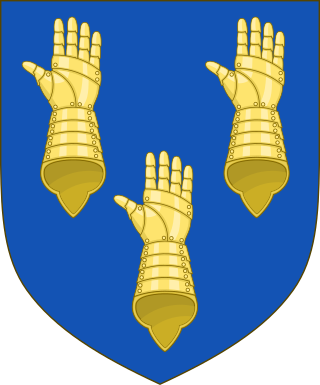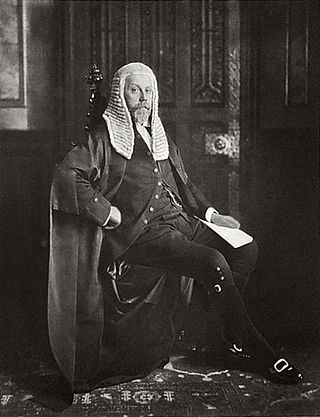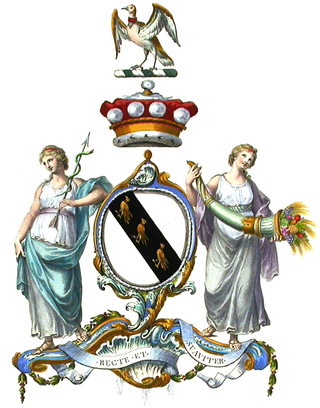The Peerage of the United Kingdom is one of the five Peerages in the United Kingdom. It comprises most peerages created in the United Kingdom of Great Britain and Ireland after the Acts of Union in 1801, when it replaced the Peerage of Great Britain. New peers continued to be created in the Peerage of Ireland until 1898

William Richard Fletcher-Vane, 2nd Baron Inglewood,, usually called Richard Inglewood, is a former Conservative Party politician in the United Kingdom. Lord Inglewood is a non-affiliated member of the House of Lords, a barrister and a chartered surveyor. He was a Member of the European Parliament from 1989 to 2004, and a junior minister in the UK government from 1995 to 1997.

Earl Ferrers is a title in the Peerage of Great Britain. It was created in 1711 for Robert Shirley, 14th Baron Ferrers of Chartley. The Shirley family descends from George Shirley of Astwell Castle, Northamptonshire. In 1611 he was created a Baronet, of Staunton Harold in the County of Leicester, in the Baronetage of England. He was succeeded by his son Henry, the second Baronet, who married Lady Dorothy Devereux, daughter of Robert Devereux, 2nd Earl of Essex. On the death of her brother Robert Devereux, 3rd Earl of Essex, she became the youngest co-heir to the baronies of Ferrers of Chartley and the barony of Bourchier, which had fallen into abeyance on the death of the third Earl. Shirley was succeeded by his eldest son, the third Baronet. He died unmarried and was succeeded by his younger brother, the fourth Baronet. He was imprisoned in the Tower of London by Oliver Cromwell and died there in 1656. On his death the title passed to his eldest son, the fifth Baronet. He died at an early age and was succeeded at birth by his posthumous son, the sixth Baronet.

Baron Barnard, of Barnard Castle in the Bishopric of Durham, is a title in the Peerage of England. It was created in 1698 for Christopher Vane, who had previously served as a member of parliament for County Durham and Boroughbridge. Vane was the son of Sir Henry Vane the Younger and grandson of Sir Henry Vane the Elder. His grandson, the third Baron, notably served as Paymaster of the Forces and as Lord Lieutenant of County Durham. In 1754 he was created Viscount Barnard and Earl of Darlington, both in the County Palatine of Durham. Lord Darlington was the husband of Lady Grace FitzRoy, daughter of Charles FitzRoy, 2nd Duke of Cleveland, the illegitimate son of King Charles II by his mistress Barbara Villiers, 1st Duchess of Cleveland.

Earl of Lonsdale is a title that has been created twice in British history, firstly in the Peerage of Great Britain in 1784, and then in the Peerage of the United Kingdom in 1807, both times for members of the Lowther family.

Earl Howe is a title that has been created twice in British history, for members of the Howe and Curzon-Howe family respectively. The first creation, in the Peerage of Great Britain, was in 1788 for Richard Howe, 4th Viscount Howe, but it became extinct upon his death in 1799. The second creation, in the Peerage of the United Kingdom, was in 1821 for Richard Curzon-Howe, 2nd Viscount Curzon, and it remains extant.

Viscount Ullswater, of Campsea Ashe in the County of Suffolk, is a title in the Peerage of the United Kingdom. It was created in 1921 for James Lowther upon his retirement as Speaker of the House of Commons. He was the eldest son of the Hon. William Lowther, third son of the Hon. Henry Lowther, second son of William Lowther, 1st Earl of Lonsdale. The first Viscount lived to the age of 93, and was pre-deceased by both his eldest son the Hon. Christopher Lowther, a Conservative politician, and his eldest son's eldest son John Arthur Lowther (1910–1942), the title being inherited by his seven-year-old great-grandson, the second and current Viscount, in an extremely rare instance of a great-grandson succeeding his great-grandfather in a peerage. The second Viscount held office in the Conservative administrations of Margaret Thatcher and John Major and since 2003 he has been one of the ninety elected hereditary peers that remain in the House of Lords after the passing of the House of Lords Act 1999.

Viscount Scarsdale, of Scarsdale in Derbyshire, is a title in the Peerage of the United Kingdom. It was created in 1911 for the prominent Conservative politician and former Viceroy of India George Curzon, 1st Baron Curzon of Kedleston, who was created Earl Curzon of Kedleston at the same time and was later made Marquess Curzon of Kedleston.
Baron de Mauley, of Canford in the County of Dorset, is a title in the Peerage of the United Kingdom. It was created on 10 July 1838 for the Whig politician the Hon. William Ponsonby, who had earlier represented Poole, Knaresborough and Dorset in the House of Commons. He was the third son of the 3rd Earl of Bessborough, an Anglo-Irish peer, and his wife Lady Henrietta Spencer, daughter of the 1st Earl Spencer. He married Lady Barbara Ashley-Cooper, the daughter of Anthony Ashley-Cooper, 5th Earl of Shaftesbury. She was one of the co-heirs to the ancient barony by writ of Mauley, which superseded the feudal barony the caput of which was at Mulgrave Castle, Yorkshire, which barony by writ had become extinct in 1415.

Baron Northbrook, of Stratton in the County of Southampton, is a title in the Peerage of the United Kingdom. It was created in 1866 for the Liberal politician and former Chancellor of the Exchequer, Sir Francis Baring, 3rd Baronet. The holders of the barony represent the genealogically senior branch of the prominent Baring family. The name Northbrook is derived from a tithing of the local parish.

Baron St Helens is a title that has been created three times, once in the Peerage of Ireland and twice in the Peerage of the United Kingdom.

Baron Burnham, of Hall Barn in the Parish of Beaconsfield in the County of Buckingham, is a title in the Peerage of the United Kingdom. It was created on 31 July 1903 for the influential newspaper magnate Sir Edward Levy-Lawson, 1st Baronet, owner of The Daily Telegraph. He had already been created a Baronet, of Hall Barn in The Parish of Beaconsfield in the County of Buckingham and of Peterborough Court in the City of London, in the Baronetage of the United Kingdom on 13 October 1892. Levy-Lawson was the son of Joseph Moses Levy, who acquired The Daily Telegraph only months after its founding.

Baron Rea, of Eskdale in the County of Cumberland, is a title in the Peerage of the United Kingdom. It was created in 1937 for the businessman and Liberal politician Sir Walter Rea, 1st Baronet, who had earlier represented Scarborough, Bradford North and Dewsbury in the House of Commons. He had already been created a Baronet, of Eskdale in the County of Cumberland, in 1935. He was succeeded by his eldest son, the second Baron. During the Second World War he served as personal staff officer to Brigadier Colin Gubbins, the Head of SOE, a key British intelligence and guerrilla operations agency. Lord Rea served as Leader of the Liberal Party in the House of Lords from 1955 to 1967. His daughter, the Right Hon. Ann Felicity Rea, married SOE veteran Malcolm Munthe in 1945. His nephew, the third Baron, who succeeded in 1981, was a physician. He was one of the ninety elected hereditary peers elected to remain in the House of Lords after the passing of the House of Lords Act 1999, and sat on the Labour benches. As of 2020 the titles are held by his son, the fourth Baron, who succeeded his father in that year.

Duke of Cleveland was a title that was created twice, once in the Peerage of England and once in the Peerage of the United Kingdom. The dukedoms were named after Cleveland in northern England.
Viscount Vane was a title in the Peerage of Ireland. It was created in 1720 for the Honourable William Vane, who had previously represented County Durham in Parliament and who later sat for Steyning and Kent. He was created Baron Vane, of Dungannon in the County of Tyrone, also in the Peerage of Ireland, at the same time he was given the viscountcy. Vane was the younger son of Christopher Vane, 1st Baron Barnard. The titles became extinct on the death of his only surviving son, the second Viscount, in 1789.
William George Cavendish, 2nd Baron Chesham was a British Liberal politician.

William Morgan Fletcher-Vane, 1st Baron Inglewood, TD, was a British Conservative Party politician.
Vane is a surname. Notable people with the surname include:

Sir Henry Ralph Fletcher-Vane was the eldest son of Sir Francis Fletcher-Vane, 3rd Baronet, and his wife, Diana Olivia. He was a Deputy Lieutenant and Justice of the Peace for Westmoreland and Cumberland and appointed High Sheriff of Cumberland in 1856. He was also a County Alderman for Cumberland and was an officer in the Westmorland and Cumberland Yeomanry, commanding the regiment from 1879 until 1891 when he was appointed the regiment's Honorary Colonel. He was the fourth Baronet of Hutton and the first cousin of Sir Francis Vane.

Earl of Arran is a title in the Peerage of Ireland. It is not to be confused with the title Earl of Arran in the Peerage of Scotland. The two titles refer to different places: the Aran Islands in Ireland, and the Isle of Arran in Scotland. The Irish earldom is held by the Gore family. The Scottish earldom is a separate title, held as a subsidiary title of the Duke of Hamilton.













